Recent Water Damage Posts
Water Damage from Rainy Days Can be a Disaster
4/22/2024 (Permalink)
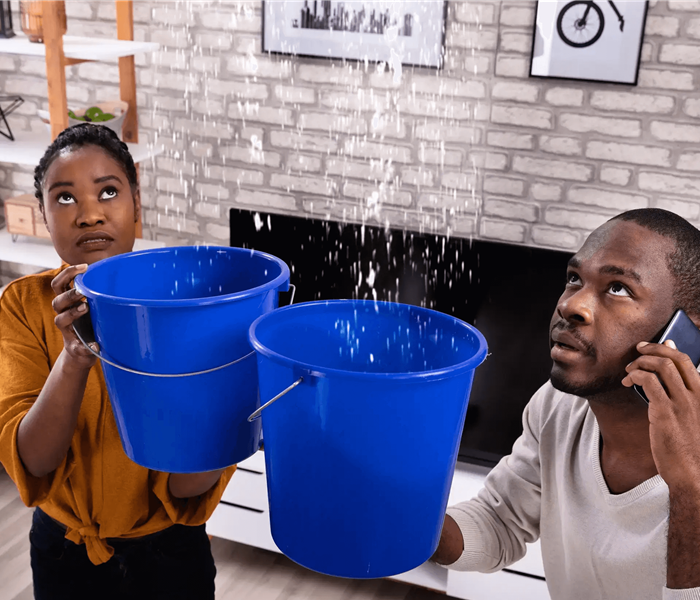 Rain Water can wreck havoc to your property
Rain Water can wreck havoc to your property
Are you experiencing water seepage indoors on rainy days? It’s important to address this problem quickly to prevent further damage to your home. Check for signs of leaks or cracks in your roof, windows, or walls.
Additionally, make sure your gutters are clear and functioning properly to make sure the water is being moved away from your home’s foundation.
Calling experts like SERVPRO® to handle water damage clean-up from rainy days is a smart move. Our professionals in water damage restoration will assess the situation to find the source of water infiltration. They will use special equipment to extract water, dry affected areas and alleviate any potential mold growth. It’s necessary to address water damage promptly to prevent further structural and health issues.
What to do if your house floods
9/18/2023 (Permalink)
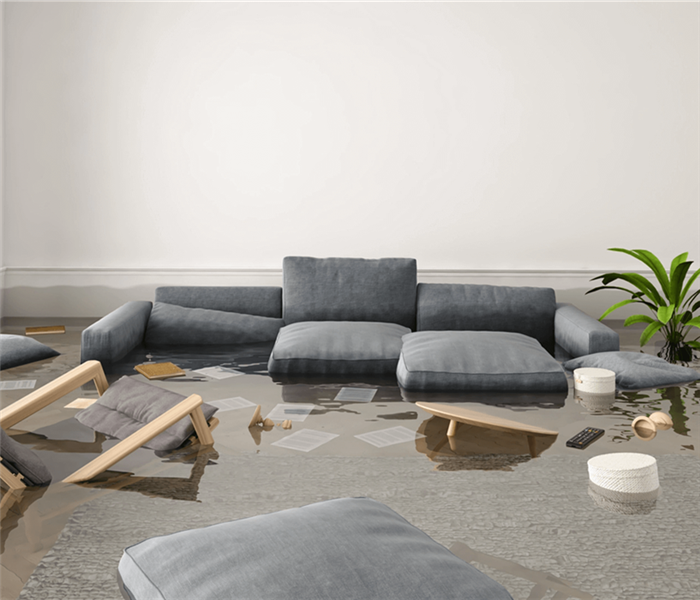 Flooding can ruin your belongings quickly.
Flooding can ruin your belongings quickly.
Experiencing a flood in your home can be a devastating and overwhelming situation. Water damage can wreak havoc on your property, and belongings. However, staying prepared and knowing what immediate actions to take can make a significant difference in mitigating the damage and getting your life back on track. We'll show you what to do if your house floods, ensuring you can act quickly and effectively during this challenging time.
Prioritize Safety First
The safety of yourself and your family should be the top priority when dealing with a flooded house. Before entering the property, ensure the following:
- Turn Off Electricity. Water and electricity are a deadly combination. If it is safe to do so, switch off the main electrical supply to prevent electrical hazards.
- Check for Gas Leaks. If your house uses natural gas, smell for any gas leaks. If you suspect a leak, leave the premises immediately and contact the gas company.
- Wear Protective Gear. When entering the flooded area, wear rubber boots, gloves, and a mask to protect yourself from potential contaminants.
Stop the Water Source (If Possible)
If the flooding is caused by a burst pipe or any other controllable factor, try to stop the water source as quickly as possible. Locate the main water shut-off valve and turn it off to prevent further water damage.
Document the Damage for Your Insurance Company
Before starting any cleanup or restoration efforts, document the flood damage thoroughly. Take photographs or videos of the affected areas, including damaged items and structural issues. These records will be invaluable for insurance claims and assessing the extent of the damage.
Notify your insurance company about the flood as soon as possible. Most homeowner's insurance policies cover certain types of water damage, but the specifics may vary. Discuss the situation with your agent and inquire about the coverage and claim process. Be sure to provide them with the documentation you gathered to support your claim. They may recommend a few water damage restoration companies, but you can also search your local area as well to see who has good reviews!
Call a Water Damage Restoration Company
Once it is safe to do so, contact your local SERVPRO team to begin the cleanup process to prevent mold growth and further damage. SERVPRO of Lee and South Chatham Counties will typically follow a system like this:
- Remove Water. Use pumps, wet-dry vacuums, or buckets to remove standing water from your property.
- Dry Out the Area. Utilize fans and dehumidifiers to speed up the drying process. This step is crucial in preventing mold and mildew growth.
- Dispose of Contaminated Items. Discard any items that have been in contact with floodwater and cannot be properly sanitized. This includes food, cosmetics, and some porous materials.
- Sanitize and Disinfect. Thoroughly clean and disinfect all surfaces, floors, and belongings that come in contact with floodwater to eliminate harmful bacteria and pathogens.
Preventive Measures for the Future
Once your home is restored, take steps to minimize the risk of future flooding:
- Elevate Electrical Systems. If you live in a flood-prone area, consider elevating electrical outlets, switches, and appliances above the expected flood level.
- Install Sump Pumps. Sump pumps can help remove water from your basement during flooding incidents.
- Seal Foundation Cracks. Regularly inspect and seal any cracks in your home's foundation to prevent water seepage.
- Proper Landscaping. Ensure the ground slopes away from your home's foundation to direct water away from the house.
Experiencing a house flood can be an overwhelming and emotionally draining experience. However, by following these steps, you can take control of the situation and minimize the damage caused. Remember, safety should always come first. Seek professional help from a water damage restoration company when necessary and take preventive measures to protect your home from future flooding incidents. With a proactive approach and the right assistance, you can overcome the challenges of a flooded house and restore your home to its former beauty.
Water Damage tips and tricks
6/20/2023 (Permalink)
Water damage is no fun! After any home emergency, the safety of your family is most important. In the case of water damage, the actions below are some things you can do while waiting for assistance. However, it’s best to do only those things you know you can do safely. Once we arrive, we’ll help you assess the situation further and take action to prevent additional damage to your property.
Shut off the water source if possible or contact a qualified party to stop the water source.
Turn off circuit breakers for wet areas of the home when access to the power distribution panel is safe from electrical shock.
Remove as much excess water as possible by mopping and blotting.
Remove and prop up wet upholstery cushions for even drying. DO NOT put cushions covers in the washing machine.
Place aluminum foil or wood blacks between furniture legs and wet carpeting.
Move any paintings, art, objects, commuters, documents or other sensitive valuables to a dry place.
Hang furs and leather goods separately at room temperature.
Don't enter affected areas if electrical outlets, switches, circuit breakers or electrical equipment are exposed to water. Always avoid electrical shock hazards!
Don't remover your household vacuum cleaner to remover water; this could cause electrical shock or damage to the vacuum cleaner.
Don't turn on ceiling fixtures if ceiling is wet or enter rooms where ceilings are sagging from retained water.
SERVPRO's professionals specialize in residential water damage restoration, with training focused on restoring salvageable items, accelerating drying time while documenting the entire restoration process.
Water Damage and your First Response
6/16/2023 (Permalink)
 Water damage from the ceiling
Water damage from the ceiling
Water damage is no fun for anyone
But what should your first response be when dealing with water damage? Call SERVPRO! A storm, flood, or plumbing problem can leave your home with extensive water damage. Immediate water removal is necessary to mitigate the damage. SERVPRO’s professionals specialize in water removal and water damage cleanup, then providing water damage restoration to your residence. Our customer-focused professionals will assess the residential water damage to your property. Then, we’ll help you understand the severity of the property damage so you’re able to make the best decisions for the restoration of your home. Our top-notch people use the most advanced equipment to detect hidden moisture and perform water extraction of any standing water. We have more than 50 years of experience in repair and property restoration so you can trust us to help you develop a restoration plan to help ensure your home is clean, dry, and restored to its pre-damaged condition.
Water Damage & Restoration for businesses
If you’re a business owner, any kind of water damage to your facility needs to be remedied quickly with the least amount of downtime to your daily business functions. A call to SERVPRO will help you get water damage repaired and restored in order to minimize downtime and prevent loss of revenue. Whatever size the water damage is to your business, we have the experience and equipment to deal with it. Our professionals will work closely with you and the other occupants of your building during the restoration process to have as little disruption as possible to your daily business activities.
It is important to have a plan in place for when your Lee and South Chatham Counties home suffers water damage
1/3/2023 (Permalink)
Bathroom backups are a frequent source of water damage. These are the most expensive in terms of damage because they are a category three biohazard. Items that are saturated often have no restoration possibilities.
A homeowner in Lee and South Chatham Counties suffered water damage from water coming from a backup. To absorb as much moisture as possible, the homeowner laid several towels on the flooring before SERVPRO technicians arrived.
Ventilation and Scoring
To prevent aspiration of moisture during water loss, techs should wear protective clothing. Another standard measure is to confine the pungent smell to the work area. This will prevent cross-contamination. The strong odor of the backup caused the techs to set up air scrubbers in order to capture the airborne particles. The techs then use their advanced moisture detection equipment, which determines if the subfloor needs drying.
Water Extraction Techniques
The equipment showed that water didn't seep into the tile flooring. It is common for techs to make several passes when removing water. This ensures that the tile flooring does not absorb as much moisture as possible. To speed up drying times, the more moisture that is collected before drying helps to reduce drying time.
No Controlled Demo Required
It is common to have the toe kicks removed from cabinets and baseboards surrounding walls when there is a sewage backup. This homeowner contacted SERVPRO techs immediately after the water loss. It helped to keep the loss down.
Odor Control
To ensure that the bathroom is safe for family members to use, it must be cleaned with antibacterial and antimicrobial cleaners. Techs can use a variety of odor control methods to eliminate any residual odors.
There is more risk of loss if water damage continues to build up in your home. SERVPRO Lee and South Chatham Counties can be reached at (919) 533-6776. The certified technicians will arrive quickly to restore your home to preloss condition.
Flooding can happen ANYWHERE
8/2/2022 (Permalink)
According to the National Weather Service (NOAA), “Approximately seventy-five percent of all Presidential disaster declarations are associated with flooding.” NOAA lists the most common flood hazards in the United States as
- Flash Flooding
- River Flooding
- Storm Surge and Coastal Inundation from Tropical and Non-Tropical systems
- Burn Scars/Debris Flows (caused by wildfires)
- Ice/Debris Jams
- Snowmelt
- Dry Wash (caused by heavy rainfall in dry areas)
- Dam Breaks/Levee Failure
Just because you haven’t experienced a flood doesn’t mean you won’t in the future. In fact, 20% of all claims paid by the National Flood Insurance Program (NFIP) were for polices in the low-risk communities. On average, floods cost $3.5 billion in annual losses in the U.S., and commercial flood claims average more than $75,000 (NFIP).
When Catastrophic water damage (or any water damage) happens to you, SERVPRO of Lee & South Chatham Counties professionals can help. It is always best to call SERVPRO of Lee & South Chatham Counties directly at 919-533-6776.
Hidden Water Damage and Mold in Your Home
7/1/2022 (Permalink)
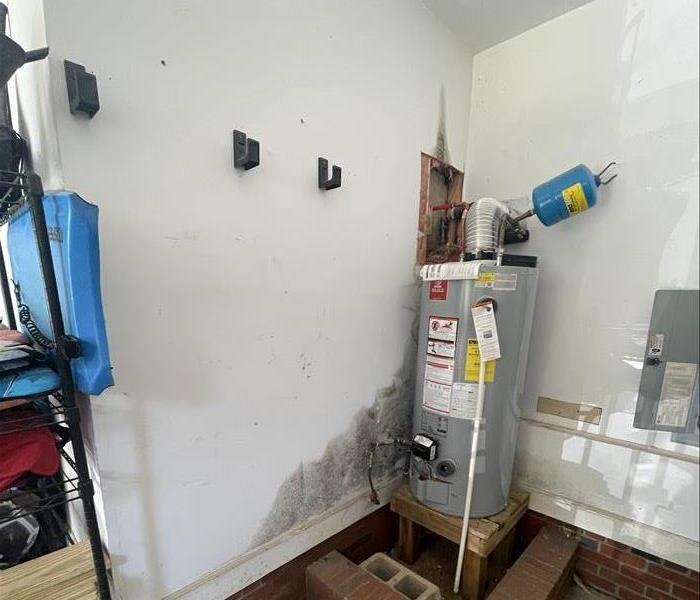 If you have mold please give us a call at 919-533-6776!
If you have mold please give us a call at 919-533-6776!
There are a number of things that can cause water damage in your home. Leaky pipes that you can't see, broken appliances, and even rain and flooding. What is important to remember is to call the professionals at SERVPRO of Lee & South Chatham Counties if you have water damage or suspect mold. There are some things to keep in mind until help arrives.
If you see visible mold, do not disturb it. You can inadvertently spread the mold infestation throughout your home. When mold is disturbed, the mold can release microscopic mold spores which become airborne and can circulate inside your home.
What to Do:
Stay out of affected areas.
Turn off the HVAC system and fans.
Contact SERVPRO of Lee & South Chatham Counties for mold remediation services (202) 737-8776.
What Not to Do:
Don’t touch or disturb the mold.
Don’t blow air across any surfaces with visible or suspected mold growth.
Don’t attempt to dry the area yourself.
Don’t spray bleach or other disinfectants on the mold.
About Our Mold Remediation Services
SERVPRO of Lee and South Chatham Counties specializes in mold cleanup and restoration, in fact, it’s a cornerstone of our business. Our crews are highly trained restoration professionals that use specialized equipment and techniques to properly remediate your mold problem quickly and safely.
If You See Signs of Mold, Call Us Today 919-533-6776.
Flood Damage Restoration Services
6/7/2022 (Permalink)
SERVPRO technicians are always watching the weather and when forecasts look grim we are prepared with our trucks loaded and ready to go, at a moments notice.
If damage does occur it is typically water damage. Flash flooding from intense rain, overflow from storm and sewer drains, overflow from rivers lakes ponds or of course the ocean are also contributing factors when we consider water damage during a storm. When this type of damage occurs it is smart to call us quickly. The faster we are able to respond to your call the faster we can begin clean up and the more likely we are going to be able to restore much of the wet/saturated property.
If a future storm has you concerned about your home or commercial property don't hesitate to call us our innovated project managers can offer several solutions to help flood prone homes and building escape large scale damage in a storm.
A Flooded Basement Can Lead To Structural Issues And Mold
5/25/2022 (Permalink)
Heavy Rain Can Mean Big Problems For Your Basement
A basement can flood at any time, although Washington DC flooding most often occurs during heavy rainfall. Basements are inherently prone to flooding because they are the lowest level of a building and are normally built partly or entirely below ground level.
There are a number of reasons why your Lee & South Chatham Counties basement could flood, including:
A blocked or failed sewer lateral pipe
Heavy rain causes surface water to pool around your home
Storm sewer backup
Sanitary sewer backup
Foundation drainage failure
Water supply-line break or hot-water tank failure
If flood water is not handled quickly and properly, it can cause severe damage to your home’s structure. Remember, the longer you wait, the worse the problem will get. Mold is also a threat if the water damage isn't treated.
If your home or business has a mold problem, we can inspect and assess your property and use our specialized training, equipment, and expertise to remediate your mold infestation.
If You See Signs of Mold, Call Us 919-533-6776.
A flooded basement can jeopardize your safety, and your home’s integrity.
It’s worth making a call to SERVPRO of Lee & South Chatham Counties and let our trained crews handle the situation safely and correctly. We have earned the trust of hundreds of homeowners, business owners, and property professionals.
We are Flooded Basement Specialists:
We are Available 24 hours/7 days per week
We’re a Preferred Vendor to many National Insurance Companies
We Bill The Insurance Directly – One Less Thing For You To Worry About
Our Technicians are Highly-Trained in Water Restoration Techniques
We use s500 IICRC Restoration Standards
Advanced Inspection and Extraction Equipment
Dirty Water Cleanups
4/1/2022 (Permalink)
Did You Know There Are 3 Varieties of Water Damage?
If the disaster seems manageable you may be tempted to handle it yourself, unlike a large flood or burst pipe. While this may seem like a cost saving idea in the short run, the hazards and future problems can become very costly. In reality, cleaning up and restoring a water damage isn’t always as straightforward as it seems.
Below we have highlighted three major things you need to be aware of when addressing water damage from a small to big water loss.
1) Know What You’re Dealing With
Water damage can be caused by the three types of water listed:
- Clean water (Category 1)
- Gray water (Category 2)
- Black water (Category 3)
It’s crucial to understand the differences between each of these categories, Category 2 and Category 3 water both present risks to you, your employees, customers and loved ones. And all three categories need to be handled in a different manner to be done properly.
Clean Water-
The most common sources of clean water normally come from a pipe, water heater, steam lines or even rainwater after a storm. The basic rule of thumb- it should look and smell like tap water. These types of water can be handled with normal water loss procedures, however recovering from Category 2 and Category 3 water damage involves additional considerations.
Gray Water-
A Category 2 water loss, or “grey water” refers to a source of water which contains a large degree of chemical, biological, or physical contaminants that can cause health effects.
Black Water-
Category 3 water loss involves water that is contaminated and can contain pathogenic, toxigenic, or other harmful agents. Such water contains things like silt, organic matter, pesticides, heavy metals, regulated materials, or unsafe substances.
2) Make Sure You Investigate All of the Damage
The challenging thing about recovering from water damage from something like a broken pipe or storm damage is that you can typically only see the visible surface damage. The majority of the moisture is actually hidden in walls, floors and more, making it necessary to identify and thoroughly dry all of the affected areas to prevent mold growth. If the wall has insulation, we will use flood cuts. We may even need to remove your base molding and flooring materials depending on damage, these are things that can become overlooked doing it yourself.
3) Establish Proper Airflow and Keep the Windows Closed When Drying
Once moisture becomes present, your first thought may be to open windows to assist in the drying process, in reality this may not be your best move. For example, if your building is mechanically ventilated, the systems need constant pressure levels to work correctly. You should avoid excess heat, cold, and humidity, or you may end up slowing the drying process. After we remove wet materials and create necessary cuts in the walls, we begin placing down drying equipment. This process continues until moisture meters read safe levels again.
No matter what type of water damage you’re dealing with, don’t hesitate to call us at 919-533-6776.
Appliance Water Damage Repair
3/28/2022 (Permalink)
It is amazing how quickly things can change when an appliance such as a dishwasher or a refrigerator begins to leak. Many times the leak can go unnoticed for days and weeks until it is too late and there is permanent damage to floors, baseboards, cabinets and more. This is where SERVPRO of Lee & South Chatham Counties can help. We are available to repair the damage caused by a leaking appliance and can work with you and in some cases your insurance company to repair the damage and restore our home.
Our team is available 24/7 when this type of water damage occurs because if the flow of water cannot easily be stopped and is significant you may need immediate help. As water begins to permeate surfaces such as particle board, drywall, laminate flooring and carpets the materials quickly become unsalvageable and must be removed and replaced, this includes insulation behind sheetrock walls. Our team is trained to measure humidity levels in these materials to determine if the can be saved or if removing them will be better to prevent structural damage.
If your home or commercial property are damaged by water from a leaking appliance, water supply or waste pipe, call us today. We are prepared to help 24/7!
Checking your new Home
2/18/2022 (Permalink)
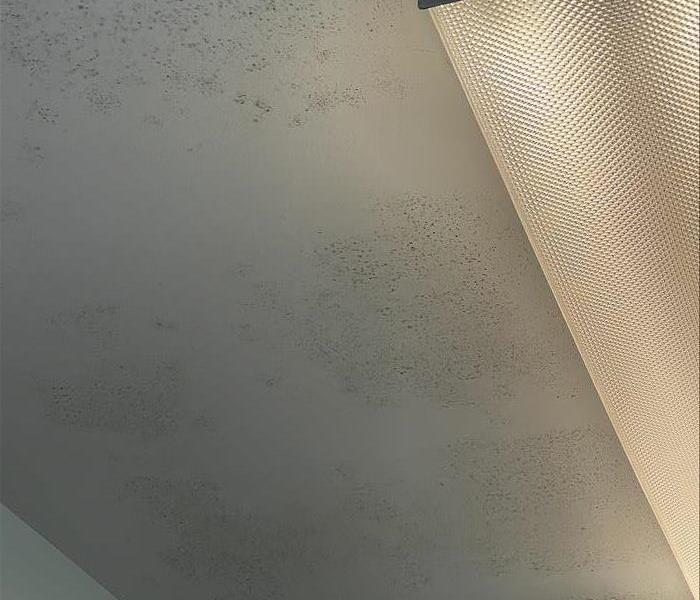 Mold on ceiling.
Mold on ceiling.
Water damage signs can be left in plain sight at times if you look. Grab a flashlight when looking at a home to buy .
Water damage can be hiding anyway but check the high risk areas at least.
Check the walls for spots and stains. Don't forget to look around doors and windows.
Check the floors for warping and buckling especially in the basement. Look for white or dark stains on wood floors, damp carpeting and a general smell of dampness and mold.
Check the piping in the kitchen, bathrooms, laundry room, and basement for corrosion around the pipe connections, leaks, or water stains. Inspect the caulking around the bathroom fixtures. Missing or loose caulking could be caused by water seepage. Look for missing grout or signs of mold. Check the water heater for wet spots on the floor and rust on the tank.
Check the attic for stains, mold, and other signs of leaks. The insulation should be dry and in good condition.
Don't forget to check the outside of the house. Check the roof for damaged flashing and missing, cracked, or curled shingles. If you see standing water anywhere outside the home, it could be the sign of a problem. The house should be situated on the highest point of the property, with the ground sloping away from the house.
Why Are There Water Streaks On Your Walls?
1/12/2022 (Permalink)
Water streaks on your walls can look unsightly. However, the problem is often bigger than just an eyesore as they could indicate mold growth, rot, and water leakages behind the wall. It is thus important to have this problem resolved as soon as possible. Water streaks on your walls could also be signs of inadequate drainage of water and condensation. Here are some of the reasons for water streaks on your walls.
Inadequate Home Ventilation
Proper home ventilation will help to remove pollutants, control heat and remove excess moisture in the environment. If your home has a persistent moisture problem and water streaks on your walls, you should try to increase your ventilation to fix the problem. For example, you can use exhaust fans in the kitchen and bathroom or other humid areas to increase air circulation and ensure proper ventilation. Do remember that exhaust fans should be vented to the exterior and not the interior.
Condensation
Condensation occurs when there is a large temperature difference between the air outside and the air inside your home. This causes condensation on interior surfaces in your houses such as walls and windows. Over time, this condensation can contribute to water streaks on your walls.
The good news is those condensation problems are relatively minor and easier to fix as compared to water leakages. You can use dehumidifiers, improve your ventilation system or exhaust systems to fix condensation issues, thereby preventing excess moisture from building in your house and on surfaces.
Roof Leaks and Ice Dams
If your roof has a leakage, water can thus seep into your home or inner walls. Cracked masonry, walls, or other damaged building structures may also contribute to the excess build-up of moisture. If you frequently observe wet patches or water streaks on your walls after heavy rain or storm, the likely culprit would be roof leaks.
It is thus important to get your roof repaired and to seek professional help as your roof may deteriorate over time. Roof leaks may also occur due to damaged roofs from improper installation and damage from heavy weather such as storms.
Ice dams can also cause roof damage and leaks in colder climates. This is because heavy snowfalls, paired with damaged roofs, or inadequate roof structures, insulation, and ventilation would contribute to ice dams. Ice dams occur when the snow on the roof melts and seeps or leaks into the roof, or your interior walls via a crack or crevice on the roof. If you observe water streaks occurring on the walls in the top of rooms which are located on the highest story, it may be due to an ice dam and roof leakage.
SERVPRO of Lee & South Chatham Counties Can Assist You with Water Damage Restoration
SERVPRO is a trusted leader in the restoration industry and possesses numerous advanced restoration and cleaning equipment. We can identify the source of your leakage and properly address the water damage on your walls.
Check the Nearest Stall, This One’s Flooded: How to Stop an Overflowing Toilet
12/10/2021 (Permalink)
How to Stop an Overflowing Toilet
Before summoning a professional to your business for a toilet overflow, you may want to follow the following steps.
1. Stop Use of Surrounding Area
If you want to stop a toilet flood, it may be necessary to stop using the faucets and toilets in the surrounding area and stalls. Any additional pressure put on the plumbing system in the surrounding area can exacerbate the issue for the single stall.
2. Close the Water Valve
While it may be necessary to stop the immediate use of the restrooms in the surrounding area, it does not have to be halted permanently. You can resume use of other stalls after you close the water valve to the problem toilet. This valve is typically located on the vertical or horizontal pipe running up the back of the toilet and can be identified by the flathead screwdriver slot. Close the valve by using a screwdriver to turn it off.
3. Use a Plunger or Check the Gasket
Once you have shut off the influx of water, you can see if the toilet overflow is due to a clog or a problem with the gasket. To see if it is a clog, you can use a plunger and attempt to flush the toilet. If the toilet flushes, then you may have a clog. If you suspect the gasket, remove the flange cover followed by the gasket, and then clean the gasket, making sure that the weep hole is clear of any buildup or debris.
4. Consult an Expert
If you have used a plunger and cleaned the gasket, but the system is still not working correctly, it may be time to consult an expert in the Lee & South Chatham Counties area. While some plumbing issues are easy enough to fix on your own, others require the investigative skills of experienced professionals.
A toilet overflow can be a nuisance, but it doesn’t have to be costly. Most issues can be resolved with a plunger or a gasket cleaning; however, in those instances where simple fixes won’t cut it, you may want to seek out a professional before the potential water damage becomes expensive and burdensome.
What is the best extraction tool for flooding in my house?
11/10/2021 (Permalink)
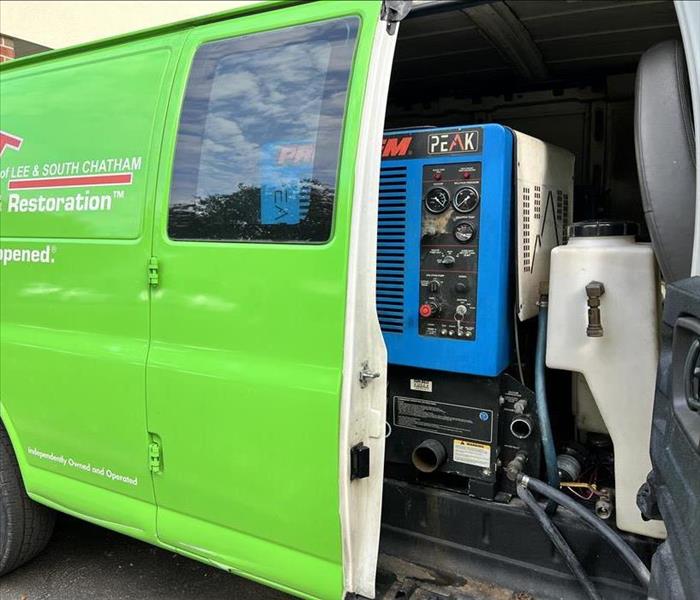 Truck-Mount Pump
Truck-Mount Pump
SERVPRO professionals have access to a wide range of water removal tools that can be used in any flood situation.
Flooding can cause a lot of water to remain on your property. If you don't act quickly to eliminate this water risk, the conditions could worsen such as structural deterioration and saturation. Our SERVPRO team can quickly take action to restore your property. Our professionals will assess your situation and determine the best equipment or products to help you achieve this goal.
Like every aspect of flood relief for businesses and homes, there are many ways to restore and recover the structure. There are many tools that can be used to extract water from a structure. The severity of the situation, depth of standing water and materials that are affected by flood water will all play a role in deciding which equipment is used. Our technicians have many tools available to them when mitigation starts. However, the most commonly used are:
- Submersible Electric Pumps
- Trash pumps
- Truck-Mount Pumps
- Wet Vacuums
- Specialty Extractors
Recovering a flooded home can feel like an insurmountable task when property owners first see the damage to their residence. Our team can help with efficient water removal, drying, and cleaning, to make all flood losses “Like it never even happened.” Give us a call today!
How Do You Dry Electronics After A Water Leak?
10/13/2021 (Permalink)
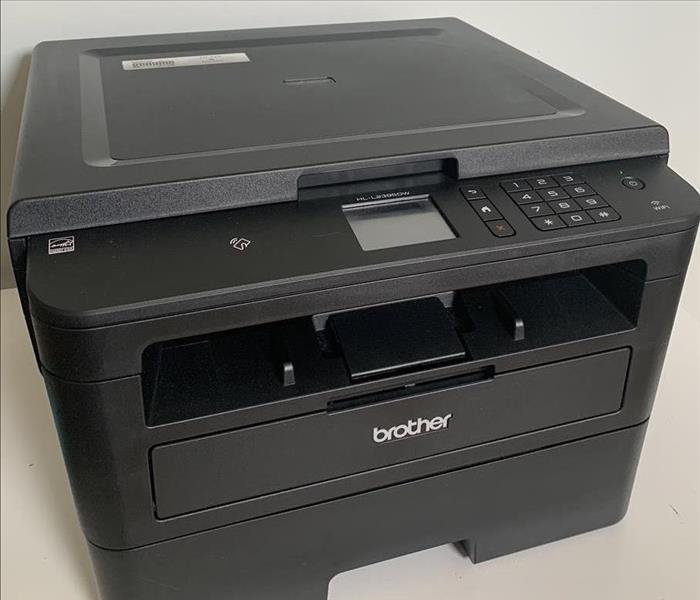 Call us at 919-533-6776
Call us at 919-533-6776
SERVPRO® professionals have the experience to help you save these resources in your home.
Leakages can cause havoc in a home. Water leaks can cause damage to electronics throughout a home. Homeowners often use their phones and tablets in multiple rooms. Experts who are familiar with how to protect your equipment and data can save you money.
What type of damage can a water leak usually cause?
A water leak can cause power problems with various electronics in your house. It is important to remove electronics from harm as soon as possible.
What are the first steps when electronics become damaged?
First, ensure there are no electrical hazards. All electronics must be unplugged and backup batteries disconnected. Fuse breakers and trip breakers also need to be removed.
What are the other steps?
All electronics should be removed from any exposed areas if possible. To prevent further water damage, electronics should be covered with plastic if possible.
What about the water leaking from the leak?
SERVPRO® professionals are skilled in removing any standing water. You should wipe away any water remaining from your electrical equipment after the water has been removed. Do not turn on the equipment until you have thoroughly evaluated it. Otherwise, further damage could be caused by running an electric charge through electronics.
What equipment can we use in addition?
SERVPRO® professionals may use dehumidification equipment to stabilize electronics. As this can lead to corrosion and condensation, electronics should not be allowed to cool to the room's dew point.
What happens if you need more specialized knowledge?
We may need to use an electronics restoration specialist in order to finish the job and ensure the integrity of the electronics.
Water Removal Services
9/17/2021 (Permalink)
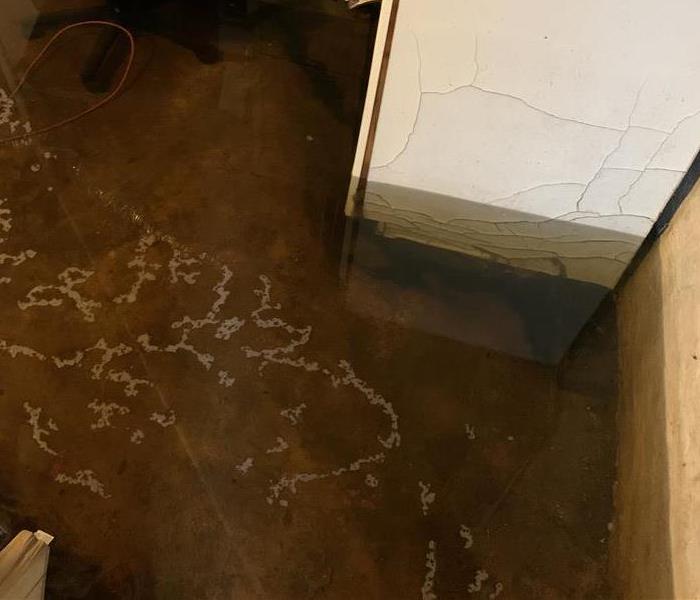 Call us for your water removal needs.
Call us for your water removal needs.
Water Removal
For large amounts of water, our team members start with pumps and other extraction devices. Our commercial pumps can remove the majority of the water in a day or two, depending on the size of the home. This initial action stops much of the damage and prevents any further issues from happening.
Next, technicians use other devices to draw water off floors and out of carpets. For closets and other small areas, they use extraction wands. They can adjust the vacuum rate on these portable devices to quickly remove the water without causing secondary damage to carpet fibers or wood floorboards.
In living rooms and other large areas, team members use extractors that move slowly under their power while SERVPRO professionals ride on or walk behind to monitor the results and adjust accordingly. If there is a pad underneath, our personnel detach the carpet from the floor, roll it up and remove the soaked foam rubber pad for disposal.
Water Clean Up
As specialists finish the carpets and floors, other team members examine the walls for damage. Drywall panels are excellent material for interior walls, but they can soak up an incredible amount of water in a short period. Even just an inch or two of flooding can cause panels to crack and crumble. If there are no visible signs yet, they can use a combination of air movers and exhaust fans to force warm air across the surface, pushing out moisture into the air and push it outside the home.
Since there is often some water behind the walls, team members remove the floor trim and drill several small holes into affected panels behind it. That allows water to drain, and then other specialists insert a hose attached to an air mover to force warm, dry air into the wall cavity to dry the panels and the wall framing.
At SERVPRO of Lee & South Chatham Counties, our task is to return every flooded home to its owner in a dry condition and safe to live in once more. It is not a simple or even a quick process in some cases, but we ensure the owner understands everything we do to place their family back into their residence as quickly as possible. If you need us, call 919-533-6776 today to get started.
What Can Happen if a Water Intrusion Isn’t Cleaned Properly?
8/5/2021 (Permalink)
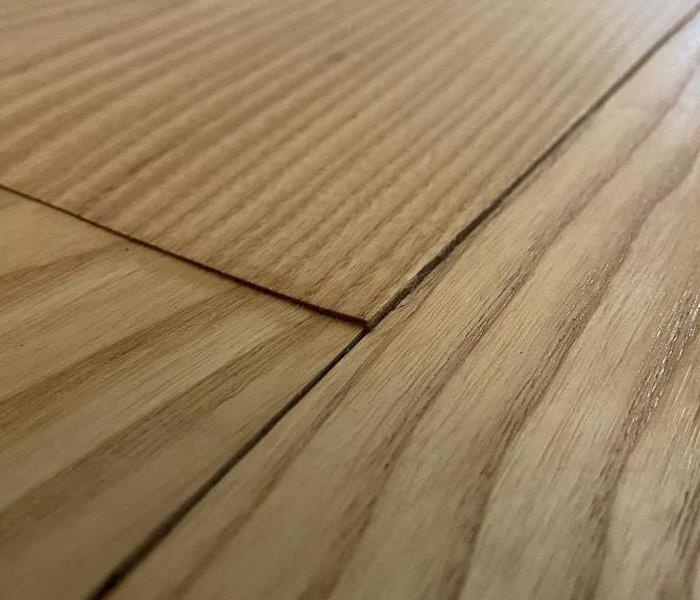 Expansion on wood floor because of water damage.
Expansion on wood floor because of water damage.
SERVPRO understands the water damage that can happen to Lee & South Chatham Counties homes and knows how to provide professional mitigation
Problems occur every day that leads to water intrusion and potential damage to your home. It can be something as simple as an appliance failure or plumbing issue. Complete water extraction and drying are crucial to avoid secondary damage.
Common Issues from Inadequate Water Removal
When moisture is not mitigated immediately, water damage in your Lee & South Chatham Counties home can be serious. DIY clean up can lead to:
- Musty smells, which can indicate mold
- Buckling sheetrock
- Warped floorboards
- Compromised structural elements
- Sagging ceiling tiles
- Discolored walls
Professional IICRC certified water damage services ensure secondary damages are kept to a minimum, if not avoided altogether. Our technicians use a combination of commercial equipment and state-of-the-art technology to make sure your home is thoroughly dried and restored to preloss condition whenever possible. The crew will:
- Trace the migration path of the water
- Use controlled demolition if necessary
- Employ the right pump for the job
- Restore instead of replace when possible
- Make sure you are completely satisfied
If you have water damage, no matter how extensive, give SERVPRO of Lee & South Chatham Counties a call at 919-533-6776.
Does Water Damage Lead to Mold in your home and business?
7/1/2021 (Permalink)
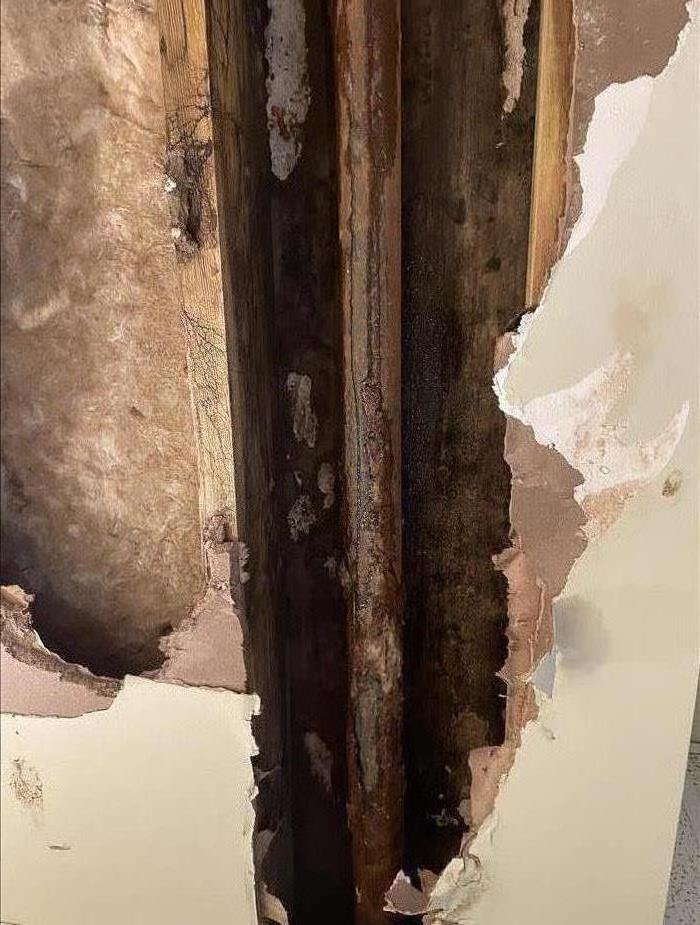 Mold developed after a water damage.
Mold developed after a water damage.
Water Damage in Lee and South Chatham Counties Can Lead to Mold
How can I avoid mold?
Whenever a water incident occurs, acting swiftly is the most critical step. It takes less than three days for mold to begin multiplying in your home if the water is left standing. When you call our SERVPRO crew, we assess the extent of the damage and jump into action as soon as it is safe. With our industry-grade tools, we can determine where water is hiding beneath your cupboards, inside wall cavities, and under flooring. We can also decide which pieces of furniture, if any, need a deep cleaning and which we need to remove from your home. So, what do we use to measure humidity in your home?
• Thermal imaging can show us water behind walls and under cabinets.
• Moisture sensors can report relative humidity in furniture and fixtures.
• Borescopes let us reach hard-to-access corners to verify moisture within them.
With a complete suite of equipment informing us of our progress, we can work to eliminate excess humidity in your home. By acting swiftly, you will significantly reduce the risk of mold growing in your home. SERVPRO of Lee and South Chatham Counties is your ally in an emergency. Call us at 919-533-6776 and let us leave your home, “Like it never even happened.”
For more about SERVPRO of Lee & South Chatham Counties click here.
How Can I Restore My Home after it Floods?
6/11/2021 (Permalink)
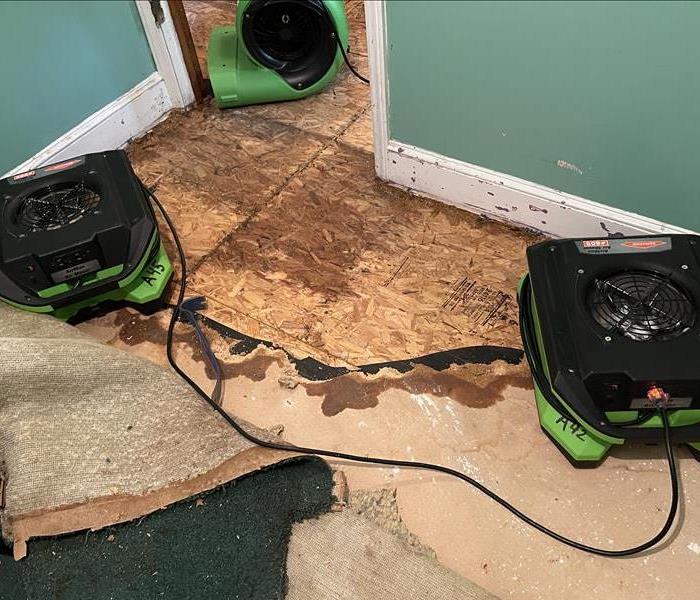 Call us at 919 - 533 - 6776
Call us at 919 - 533 - 6776
Call SERVPRO of Lee & South Chatham Counties to return your Sanford home to a dry, safe condition
Water damage in your Sanford home can be a real disturbance. It can stop all your plans in a moments notice. Water can cause a lot of damage if it isn't cleaned up properly.
Why can’t I just rent a water-vac and do it myself?
SERVPRO uses commercial-grade equipment to restore your Sanford home and business from water damage with more power and options than anything available at a DIY or retail store. Our technicians also follow a careful process that ensures we do not miss anything and provide a safe environment once again.
- Inspection and Assessment – Team members examine the home to make certain we understand the damage extent and have the equipment needed for restoration.
- Water Removal & Extraction – Here, we use pumps and smaller vacuum units to draw out the majority of the water in your home.
- Drying the Structure – Technicians use air movers and dehumidifiers to lower humidity and draw moisture out of structural property like wall framing and drywall.
- Cleaning and Sanitizing – Specialists clean off any debris that may have been brought up by the water and deodorize restorable items.
Is there anything else that needs to be done?
Now technicians physically restore affected property. This includes replacing floor trim, drywall, and other paneling, as well as installing new carpeting, wood flooring, tile, and linoleum.
If you have water in your home, contact SERVPRO of Lee & South Chatham Counties (919) 533 - 6776 immediately. We are here to help you restore your home and business to a dry, safe condition.
Drying Principles - Structure and Contents
5/25/2021 (Permalink)
When working within a residence, it is often the case that those who are performing the water damage restoration must work with and around the contents of the home. This includes, but is not limited to, furniture, electronics, books, and any other materials that may have been affected by the water damage. The moving around of the said contents is often referred to "contents manipulation." Water damage restoration firms often bill content manipulation on a per hour basis.
Contents may also require treatment due to the effects of water damage. This may include, but is not limited to, sterilization, sanitization, deodorization, drying, and storage of said contents. Other contents may simply be unsalvageable, or the cost of having them salvaged would exceed its current value.
Monitoring
After the water has been extracted and any non-salvageable materials have been removed, water damage professionals should place drying equipment according to industry guidelines for capacity in the affected areas. Industry standards state that drying vendors should return to the residence at regular time intervals, preferably every twenty-four hours, to monitor the equipment, temperature, humidity, and moisture content of the affected walls, contents, or other affected materials. Should one area be dry and another affected area still wet, the firm will relocate or remove equipment accordingly.
Completion
Once temperature, humidity, and moisture content are deemed acceptable according to industry standards, drying equipment is removed and the drying process is complete. There are defining criteria and methods to be used for assessing water damage and establishing restoration procedures, but because of the unique circumstances of every water damage restoration project, it is impractical to issue blanket rules that apply to every situation. In extenuating circumstances, deviation from standard practices is appropriate.
Step-by-step process
Though the water seepage will stop once the source of water has been identified and plugged, the problem does not end there. It is essential to determine the appropriate water extraction method, which may range from the use of a wet-dry vac unit to more heavy duty equipment like submersible pumps. Once this has been completed, the process of drying and dehumidification should start. Oftentimes, affected surfaces and areas look dry once the water has been extracted and removed, but there remains hidden water and moisture. This would call for the use of drying and dehumidifying equipment. As such, carpets, walls, and flooring require removal, drying, cleaning, and disinfecting.
SERVPRO of Lee & South Chatham Counties 919-533-6776...We are here to help!
Water Damage Emergency Tips
4/11/2021 (Permalink)
When an emergency happens people tend to panic and sometimes do not have the proper tools to calmly deal with the situation. When water affects your house whether it be due to a heavy storm or a broken water heater it is always good to be informed on what to do next.
As in any emergency, safety should be you number one concern, and a water damage situation is no different!
- “Is it safe to stay in the house?” This should always be the first question you ask yourself. If the water damage has any potential to put you or your family at risk, then leave the house.
- Electrical and “slip and fall” hazards are some of the most common concerns. Be sure to shut off an power source it is safe to do so safely.
- Wet materials can be very heavy, so be careful when moving them.
- Be sure to only do things to your house that are safe for you to do and leave the rest to the remediation crew.
Content by: SERVPRO Corporate
What Type of Water Emergency do I Have?
1/31/2021 (Permalink)
Water Emergencies Vary Depending on the Source of Intrusion; SERVPRO Restorers Identify Water Types Quickly to Provide Viable, Time-efficient Solutions
What are the categories of water intrusion?
Water intrusion has three distinct categories that can influence the method of water in your Lee & South Chatham Counties home. Clean water emergencies pose no threat to human health and have minimal impact on the home environment, while greywater emergencies have moderate contamination levels in the water and pose a minor risk to our health. These contaminants may include fungus and bacteria. Blackwater emergencies are the most contaminated type of water damage and pose a high-level threat to human health. These require significant removal and disposal of building materials that contacts blackwater. Water categories are fluid and can become increasingly severe over time- moving from clean water to blackwater in as little as seventy-two-hours.
How can I identify the water-threat level in my home?
- Cleanwater usually comes from a clean source. These may come from sources like drinking water pipes and rainfall.
- Greywater emergencies are most likely to occur from your plumbing system that transports wastewater from the property. These may include kitchen sinks, showers, or bathrooms. Greywater does not include sewer backups.
- Blackwater emergencies come from exterior flooding, sewer backups, septic tanks, or when greywater emergencies degrade over-time. These require personal protective equipment (PPE) to restore safely.
Do I need qualifications to restore water spillage in my home?
In all but the most minor of water spills, having expert experience is helpful. Drying a property may take several days and involve complex equipment. During the drying procedure, maintaining the right atmospheric conditions is essential to prevent water degradation or secondary damage. SERVPRO achieves the right atmospheric conditions by measuring them consistently using a thermal hygrometer. We can use portable heaters, drying tents, dehumidifiers, and air-movers to maintain the ideal drying conditions, reducing the time it takes to restore your property to its original condition.
To identify and restore all types of a water emergency, contact SERVPRO of Lee & South Chatham Counties 919-533-6776.
Don't let water damage control you!
11/10/2020 (Permalink)
According to the National Weather Service (NOAA), "Approximately 75% of all Presidential disaster declarations are associated with flooding." NOAA lists the most common flood hazards in the United States as: - Flash Flooding - River Flooding - Burn Scars/Debris Flows (caused by wildfires) - Ice/Debris Jams - Snowmelt - Dry Wash (caused by heavy rainfall in dry areas) - Dam Breaks/Levee Failure - Storm Surge and Coastal Inundation from Tropical and Non-Tropical Systems
Just because you haven't experienced a flood doesn't mean you won't in the future. In fact, 20% of all claims paid by the National Flood Insurance Program (NFIP) were for policies in low-risk communities. On average, floods cost $3.5 billion in annual losses in the United States.
When catastrophic water damage happens to you, SERVPRO of Lee & South Chatham Counties can help. We can help you prepare ahead of time with an Emergency Ready Profile, or respond to any size disaster to begin cleanup and restoration to get you back into your home as soon as possible. We are ready to help make it "Like it never even happened."
Call today! 919-533-6776
We are available in Pittsboro, Chapel Hill, Siler City, Sanford and surrounding areas!
Water intrusion is just frustrating!
7/22/2020 (Permalink)
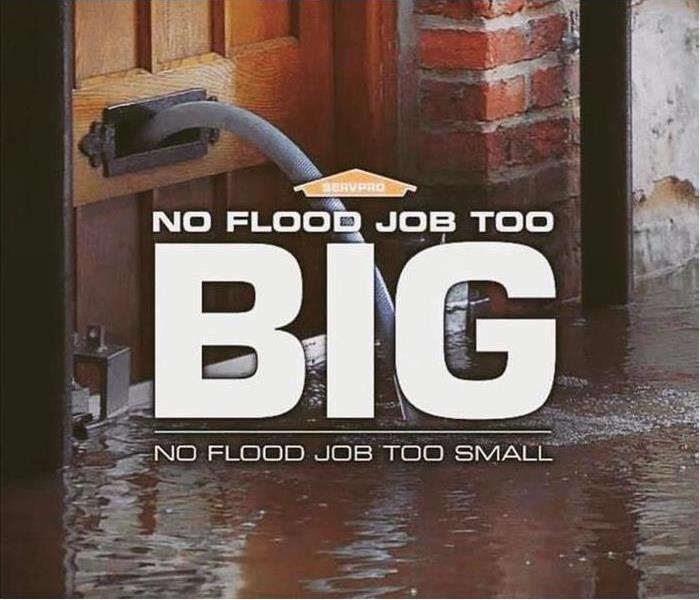 This picture is indicating that our SERVPRO can handle any size job and we ready to help you!
This picture is indicating that our SERVPRO can handle any size job and we ready to help you!
Water intrusion in a home or business is a traumatic event. Effectively restoring a water-damaged building and its contents is a valuable service to a homeowner or business owner, as well as to the insurance industry. In residential homes, the normal lifestyle of residents is severely disrupted.
This type of disruption creates stress and uncertainty for many individuals. You can help. In commercial properties, business interruption can be devastating and costly. A professional water restorer can provide guidance and assistance to help business owners make the best decisions through these difficult times. These are many of the factors that drive SERVPRO professionals to make it “Like it never even happened.”
Often in a water damage project, only a portion of a building was impacted. To dry the wet areas most efficiently, drying zones are established within the building. A drying zone is an area where you control the humidity, airflow, and temperature to speed the drying of wet materials.
We are available in Pittsboro, Chapel Hill, Siler City, Sanford and surrounding areas!
Pool party in your house or outside of your home?
7/17/2020 (Permalink)
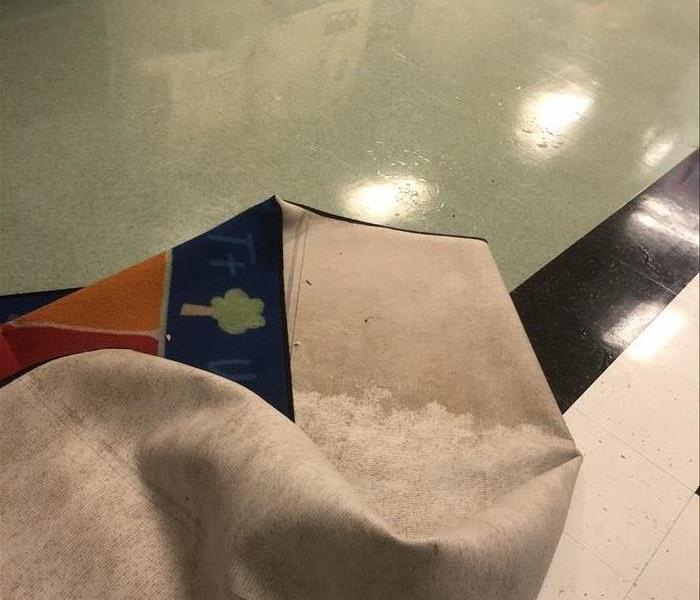 A daycare in Raleigh, NC had a water loss. This picture depicts a water damaged rug and we were able to resolve the water loss.
A daycare in Raleigh, NC had a water loss. This picture depicts a water damaged rug and we were able to resolve the water loss.
The month of July is so hot. Everyone seems to love water events but let's keep the water on the outside of your home!
We classify water as categories. Category 3 is the highest category. It is normally brown water such as sewage. For Category 3, we determine if any potentially at-risk people are in the building or home and advise our client that those people need to be evacuated. While processing this job - we will have a full face respirator equipped with the appropriate filters. We are very particular with protection of our employees and our clients.
We are trained to perform emergency services in water damage situations safely. We only practice safe measures while in buildings and customer homes. During the safe measures, we involve the personal protective equipment. This includes many items. Chemical resistant gloves are worn to protect hands from substances and becoming contaminated. We also use heavy duty gloves and that protects the hands during demolition and removal of structural materials. At certain jobs, we also use splash goggles. During this unprecedented time, we use respirators while this virus is still active. We want our customers and employees to be and stay safe! Call us today! We can help you!
We specialize in water, fire AND mold. We can also accommodate other services. 919-533-6776
We are available in Pittsboro, Chapel Hill, Siler City, Sanford and surrounding areas!
Pictured: A daycare in RALEIGH, NC had a water loss. We were on site soon after we received the call. We were ready to take action and to restore!
Mitigation tips after a water damage.
7/17/2020 (Permalink)
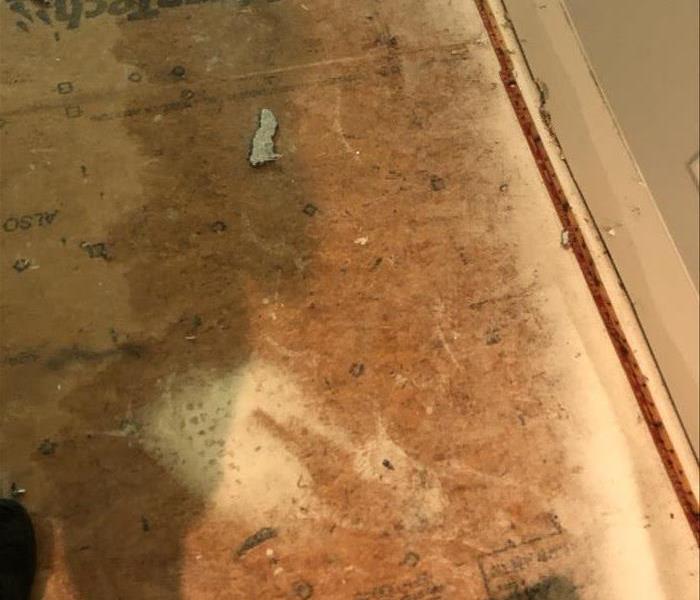 A water loss occurred in Chapel Hill, NC. We were there in record time to access and start the mitigation project.
A water loss occurred in Chapel Hill, NC. We were there in record time to access and start the mitigation project.
SERVPRO is here to help. This is what we specialize in. We want to help and ease your mind about a terrible event that has happened.
We do not want anyone to experience a water loss but we do HIGHLY recommend to have an emergency plan or call list. If something happens with an exploding pipe - have a plumber's number close to your phone. You always want to have a plan in case something does happen.
We recommend the following:
- Takes photos or video to record all previous conditions and structure. Make sure images clearly record the pre-existing structure.
- Once water damage has occurred, remove as much excess water from furniture after removing lamps and tabletop items.
- Remove and prop up wet upholstery cushions for drying purposes.
- Once we are on site, we will place fans. Do not reset or change orientation.
- Do not leave books, newspapers or magazine on wet carpets or floors. It can cause staining.
- Do not turn on ceiling fixtures if ceiling is wet or enter room where ceilings are sagging from retained water.
- Do not turn on heat unless required for human comfort.
- Do not move objects or collections without documenting their conditions.
We are willing to help you in this unforeseen event. We understand that the process is not easy. Emotions take over and they are not always easy to deal with. We are here to help and to ease your mind.
Call us today for an incredible experience and an even better understanding of the work that will be performed.
-
WATER TIME! THREE TWO ONE!
7/8/2020 (Permalink)
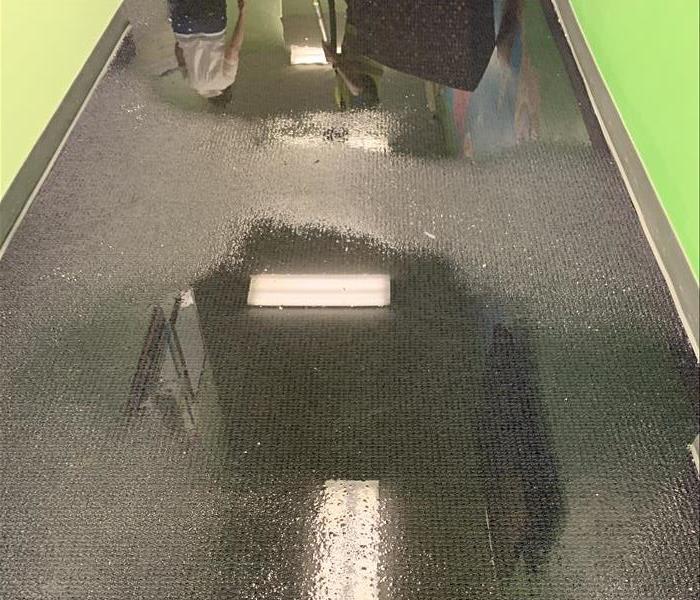 Daycare in Raleigh had an extreme over flow.
Daycare in Raleigh had an extreme over flow.
WATER WEDNESDAY!
Did you know that there were two primary ways to remove water from a residence or building? The two ways are extraction and evaporation.
Extraction is the more effective way of removing water!
Evaporation is used mainly on crawlspaces, stairwells and basements.
We like to handle water jobs in a specific manor. We want to take care of our customers and want them to feel safe with us. We have a process that follow and it is efficient.
We get to know the job and what it consists of. We also get to know the customer and make sure their understanding is accurate. After that - we will then schedule an appointment. Once we are on site then we conduct a walk through where many things will be addressed. Anything that we are able to see - we will let the customer know as well as the adjuster if applicable. Once we speak to the customer then we will have an emergency action plan in place. They then will know what to do if this happen again and they'll know who to call. After we speak to our customer and fain authorization - we will then make appropriate calls in order to start the mitigation process. If demolition is needed then that will be addressed as well during the mitigation process. Our main goal throughout this is to dry the home and also keep the customer with happy thoughts and positive feelings about our crew and the process.
Let us help you! Did you have an unexpected leak or an overflow? Call us today! 919-533-6776
How to Prevent Your Pipes from Bursting in Winter
5/25/2020 (Permalink)
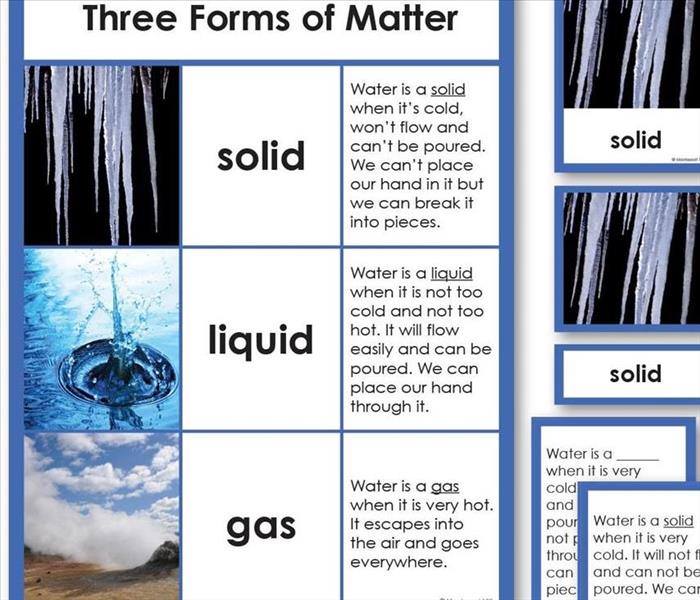 Three forms of water which can all "hurt" your home.
Three forms of water which can all "hurt" your home.
How Does Ice Burst Water Pipes?
- Keep your garage door closed!
- Open cabinets under the sink and in the bathroom, so that they can be reached by the warm air in your home
- Insulate pipes
- On exceptionally cold nights below freezing leave your taps dripping slightly. This might waste a small amount of water, but the wasted water will cost you less than having to replace busted pipes
If your pipes have burst or you notice them leaking, then it’s best to go ahead and turn off the water at your main line.
Then you’ll want to call a plumber, depending on the severity, you’ll also need to call a Water Damage Restoration Company.
While we hope you never experience a disaster in your home, we do know we are ready to help you restore it in the event of one. Just give us a call any time 24/7 we are always here to help.
SERVPRO of Lee & South Chatham
SAY NO to moisture in your crawlspace.
4/10/2020 (Permalink)
The most common cause of crawl space flooding is rain water. When excessive rain water accumulates in the soil next to your foundation it will over-saturate the soil. Unable to be soaked up by the soil, it will seek another place go. The path of least resistance will be through your foundation, especially if there are any cracks in the walls. But, you can protect yourself from crawl space leaks and flooding by taking a few preventative measures.
Keep rainwater away from your foundation. Make sure your gutters, especially your downspouts, are working properly. Clear out any clogs and repair any significant leaks. Make sure your downspouts are draining rain water five feet away from your foundation. If your gutters and downspouts are set up and working correctly, but you still notice water pooling near your foundation, you probably have an issue with the grade of your yard and may need to have a landscaper fix the problem.
Use vapor barrier. Crawl spaces are most commonly located where water runoff is common. They are also often designed with dirt floors. This makes crawl spaces an ideal breeding ground for moisture and mold. Vapor barrier can keep crawl space moisture/mold at bay.
Use a sump pump in your crawl space. Sump pumps move water away from your foundation, and moving safely away from your house. And of course, they work just as well in crawl spaces as they do in basement. Be sure you have a backup power source for your sump pump and check its operation periodically.
Let your SERVPRO of Lee & South Chatham Counties help you! :) Call us today.
Water loss - DO and DON'T
4/9/2020 (Permalink)
If you have a Category 1 or a "Clean Water" Water Damage at your home or business here are some tips to follow:
DO:
- Shut off the water source of water if possible, or contact a qualified party to stop the water source.
- Turn off circuit breakers for wet ares of the building, when access to the power distribution panel is safe from electrical shock.
- Remove as much excess water as possible by mopping and blotting.
- Place aluminum foil or wood blocks between furniture legs and wet carpet.
- Remove to a safe, dry place any paintings, art objects, computers, documents and other materials that are valuable or sensitive to moisture.
- Use wood clothes pins to keep furniture skirting off damp floors.
- Hang draperies with coated hangers to avoid contact with carpeting or floors.
- Hang furs and leather goods to dry separately at room temperature.
DON'T:
- Enter rooms with standing water where electrical shock hazards may exist.
- Enter affected areas if electrical outlets, switches, circuit breakers or electrical equipment are exposed to water. Always avoid electrical shock hazards.
- Leave books, newspapers, magazines, or other colored items on wet carpet to cause staining.
- Leave Oriental rugs or other colored rugs on wet wall-to-wall carpets to cause staining.
- Use your household vacuum cleaner to remove water possibly causing electrical shock or damaging the vacuum cleaner.
- Use TVs or other appliances while standing on wet carpets or floors, especially not on wet concrete floors.
- Turn on ceiling fans if ceiling is wet, or enter rooms where ceilings are sagging from retained water.
SERVPRO of Lee & South Chatham Counties is available 24 hours 7 days a week. Please call us today if you have a water damage at your home or business at 919-533-6776.
Water and Hardwood Floors DO NOT mix well and here's why.
3/27/2020 (Permalink)
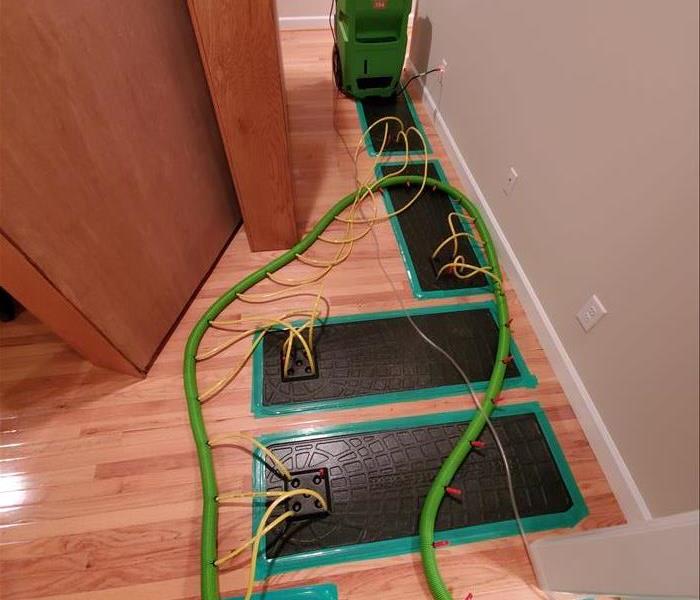 Water damage occurred to these hard wood floors. We have equipment in place to try and reverse the damage and to reduce cupping.
Water damage occurred to these hard wood floors. We have equipment in place to try and reverse the damage and to reduce cupping.
Water damage is never a good thing for your home but it’s especially true for your hardwood floors. In fact, one of the most common questions we’re asked is whether or not a customer’s wet hardwoods can be saved. The answer to that depends, but it helps if you understand why it’s bad to begin with.
How Water Warps Hardwood Flooring
When water floods areas with hardwood floors, the material tries to absorb the water. Unfortunately, excessive moisture forces the wood to expand, which can cause warping or cupping. This is why we always encourage water damage victims to extract as much water as possible while they wait for help to arrive.
Saving Water Wet Hardwood Floors
In some cases, we can save your hardwood floors. If the water is quickly extracted and there isn’t significant warping, then we can use a drying process specifically designed for hardwood floors. But if the flooring was exposed to moisture for a significant period of time and shows major signs of warping, then your hardwoods will need to be removed and replaced.
Call Professionals Before It’s Too Late
While it’s possible to save your water-damaged hardwood flooring, time is a critical factor. If you notice water damage in your home, call a professional cleanup and restoration company like our team here at SERVPRO of Lee & South Chatham Counties. We are available for 24/7 emergency services, so if you need help, call us any time at (919) 533-6776
WATER DAMAGE CAN CAUSE A FLOOD OF EMOTIONS
2/12/2020 (Permalink)
 Water damage turning into mold damage.
Water damage turning into mold damage.
Water damage is definitely on a spectrum. A spectrum of the high and low. It could be that your refrigerator is leaking and you received a small puddle on your floor. It could also be that your shower pan has had a small leak for years causing it to seep through the material into your floor causing rot and mold. Neither is to blame yourself for. I would just pay attention to the smaller details especially when it is dealing with water. An excess of water being left for over 24 hours is subject to start growing mold on the material that was in contact with said water. Water damage is easier to handle than water and mold combined. On this particular job, the homeowner knew there was a leak but was not aware of how long it was going on. We then pulled up the shower pan and discovered extreme damage alone with fungal growth.
Call us today for any needs! We are here for you.
Pipe Freeze in Chatham and Lee County Homes
1/23/2020 (Permalink)
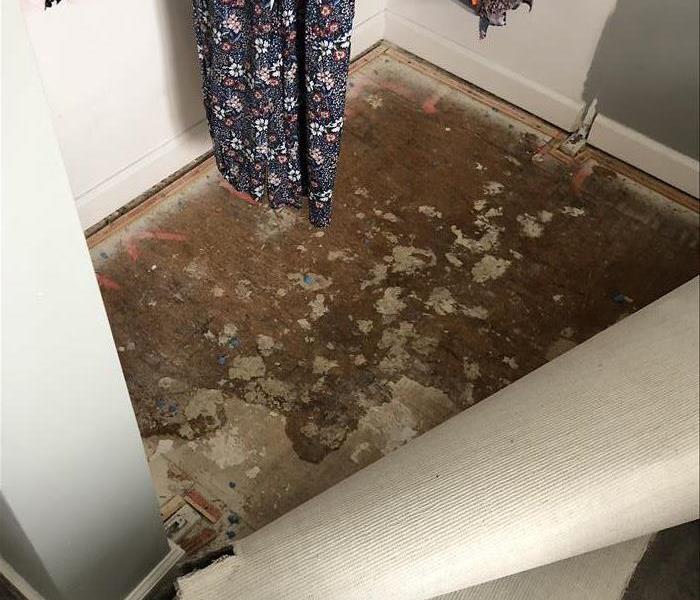 If you experience this unfortunate event then call us so we can make it "like it never even happened".
If you experience this unfortunate event then call us so we can make it "like it never even happened".
If winter weather causes water damage to your home or property, we are only a call away!
Frozen pipes occur when exposed to cold weather, such as those outside your house, or in areas such as basements, attics, garages or kitchen cabinets. A frozen pipe can burst at the point where the ice blockage inside the pipe is located, but typically the rupture is caused from the back-flow of pressure between the water source and blockage.
Water is one of the strongest forces on the planet. It can wash away homes and office spaces in a single, powerful flood, or makes a home unlivable with tiny drops over several years. Water damage may take many different designs and forms.
Let US serve you and make it "Like it never even happened."
Pittsboro Can Benefit from SERVPRO's Rapid Water Removal Efforts
12/2/2019 (Permalink)
Lacking a Shut-Off Valve Can Cause Severe Water Damage in Pittsboro Homes
The older Pittsboro homes may not always have the modern conveniences in areas like plumbing and construction to help keep them protected in case something goes wrong. For example, many older homes got constructed without the installation of a shut off valve inside of the house to prevent flow from the main water line outside through the water meter and into the plumbing network. If something should occur that ruptures or damages any portion of this plumbing line, you then have to wait until workers can arrive to shut off the flow through the meter itself to prevent more water from spilling into your house.
While it might be simple to suggest that you should have a shut-off valve installed in your Pittsboro home to help prevent water loss, many homeowners do not realize this fact until disaster strikes. With no time to react to the situation, the best solution is to contact our SERVPRO rapid response team to get our Green Fleet rolling out to your address. We have the advanced equipment to help dry up the damage and to make minor repairs to the plumbing network as well, which can help to preserve construction elements within your home from requiring replacement.
The faster that our IICRC certified technicians can arrive at an emergency like this, the easier it becomes to mitigate the damage that has occurred within the structure. Regardless of the severity of the problem, waiting too long for water removal and restoration work can allow for secondary effects like mold growth to begin. This situation of intrusive water requires industry-leading equipment and techniques to reduce the damages. We strive always to restore and not replace whenever possible.
We have truck-mounted pumps in our SERVPRO Green Fleet to rapidly extract water from affected areas of your home. We can combine the efforts of our air movers that force moisture into the air and our dehumidifiers which pull that vapor out of the environment, for fast drying efforts to protect your home.
Our SERVPRO of Lee & South Chatham Counties rapid response team is available 24/7 for any emergency that your home faces. We have the advanced equipment and highly-trained technicians to make a difference quickly. Give us a call anytime at (919) 533-6776.
Pittsboro is right here.
Steps To Take in Order To Reduce Water Damage Within The Home.
5/29/2019 (Permalink)
How we help to remediate the issue:
1. Stop the flow of water. If you haven’t been able to for any reason we will do it immediately upon arriving on the property.
2. We start removing any standing water. Depending on the amount of water we bring various pieces of equipment. We bring extractors for multiple surfaces and inspect the floors, carpets and walls.
3. We draw out any remaining water trapped on carpets and floors as long as there is no permanent damage.
4. We lower the moisture readings in the air after the water has been removed. To do this we use dehumidifiers to draw moisture out of the air. It’s also used as a preventative of rot and possible mold growth in walls and on the floors.
Water Damage Needs Attention Too
5/27/2019 (Permalink)
Water heaters work hard for you, providing warm baths, clean clothes, and sparkling pots and pans. So show your water heater some love by following a routine maintenance schedule that will keep it running for its 15-year expected lifetime, and perhaps beyond.
Adjust the thermostat to 120 degrees. You’ll save up to 5% in energy costs for every 10 degrees you lower the temperature, plus you’ll reduce the risk of scalding.
Always maintain 2 feet of clearance around the appliance unless the manual specifically states otherwise.
Drain about a quarter of the tank a few times a year to remove sediment and debris. Turn off the cold water supply, hook up a garden hose to the drain valve, then run into a bucket until the water is clear. If the water remains cloudy, briefly open the water supply valve to stir up remaining sediment, and drain the tank again. This also makes the unit operate more quietly.
SERVPRO - Lee & South Chatham Counties
Water Restoration Tips - Pittsboro
3/7/2019 (Permalink)
What To Do After Flooding
Remove excess water by mopping and blotting.
Wipe excess water from wood furniture after removal of lamps and tabletop items.
Remove and prop wet upholstery and cushions.
Place aluminum foil or wood blocks between furniture legs and wet carpeting.
Turn air conditioning on for maximum drying in summer.
Remove colored rugs from wet carpeting.
Remove art objects to a safe, dry place.
Gather loose items from floors.
What NOT To Do After Flooding
Don't leave wet fabrics in place. Hang furs and leather goods.
Don't leave books, magazines or other colored items on wet carpet or floors.
Don't use your household vacuum to remove water.
Don't use television or other household appliances.
Don't turn on ceiling fixtures if ceiling is wet, and keep out of rooms where ceilings are sagging.
Pittsboro Properties, Water Loss, and Yeah for SERVPRO!!
3/4/2019 (Permalink)
 Some of SERVPRO's Arsenal of Drying Equipment to Rescue Water Damaged Pittsboro Homes
Some of SERVPRO's Arsenal of Drying Equipment to Rescue Water Damaged Pittsboro Homes
SERVPRO - Water Removal Actions For Pittsboro Homes
While pictures of Pittsboro surrounded by a flood make good news, area homes usually suffer water dropping into their residences from more mundane sources like a split water line leading into a washing machine or a poorly insulated inlet pipe that cracked in the winter weather.
Pittsboro water removal needs accomplishing quickly and efficiently to eliminate the effects of flooding in a Pittsboro home. SERVPRO restoration teams have years of experience and training in Central North Carolina to accomplish that.
Drawing outstanding water is our first step. If the water is more than two inches deep, our technicians begin with commercial grade pumps that can remove hundreds of gallons per day, depending on the size of the pump required for the job.
After the pumps, or in cases where the water is about two inches deep or less, team members begin with smaller extraction wands. They can adjust these devices to quickly remove water off floors and out of carpets without harming the surface of either. If the power is out in the home, our teams can bring generators to provide power 24/7 until they complete the task.
Now, SERVPRO specialists examine the sub-flooring and crawlspaces. If they find any standing water, team members lift several floorboards off the framing or drill spots normally under furniture or behind floor trim to remove it. Personnel uses air movers with hoses to force warm, dry air into these cavities to speed up the evaporation process. When there is no more visible water, they use moisture meters to check the space and ensure the air moisture content is normal.
Team leaders also use thermal hygrometers to check the humidity levels in each room. If the levels test over 40 percent, specialists set up dehumidifiers to draw water from the air; up to 20 gallons over 24 hours where the humidity is very high. Lowering the humidity not only provides a more comfortable environment but also reduces the risk of mold spores expanding and growing in areas like the bathroom or laundry rooms.
These first actions help our SERVPRO of Lee & South Chatham Counties teams return your home to livable condition after water forces you out. Our goal is to provide a dry, safe residence as quickly as possible. If you need us, call (919) 533-6776 today.
Here is contact for your local govt
SERVPRO, Water Loss in Pittsboro, and a Reliable Partner
1/8/2019 (Permalink)
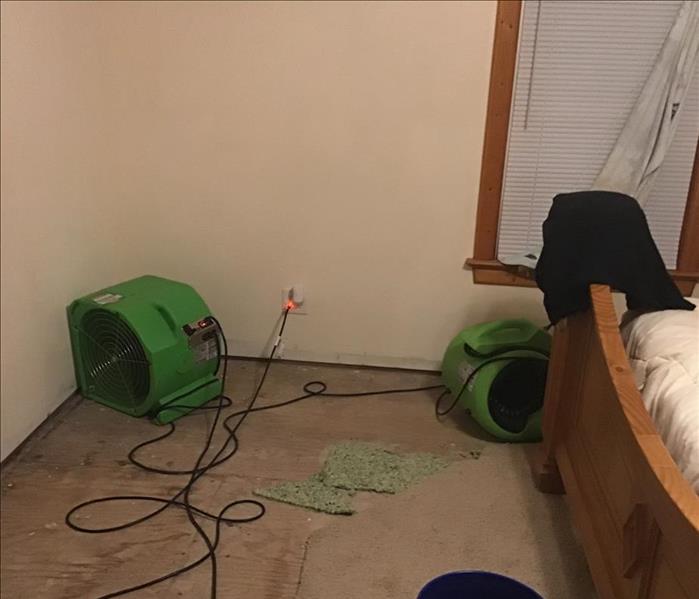 SERVPRO Removes Water and Restores Losses in Pittsboro
SERVPRO Removes Water and Restores Losses in Pittsboro
A Quick Guide to Water Cleanup in Pittsboro
Imagine getting a call from a neighbor regarding your winter home in North Carolina only to find out that water has seeped into your home and you are miles away from the problem. Regardless of what the culprit is, a broken pipe, a faulty window or another structural issue, you must react quickly to avoid further damage and to return your home to its preloss condition as quickly as possible. Knowing whom to call in case of emergency is key in keeping damage to a minimum.
Water cleanup in Pittsboro can be entrusted to our SERVPRO technicians who have been trained to act quickly and effectively to mitigate damage caused by water sources to your home. Our ability to respond to emergency calls 24/7 gives great peace of mind to our clients, even when they are miles away from home. Our thoroughly trained technicians jump into action as soon as the call is received and they report to your property prepared to address the immediate need for water extraction all while protecting and safeguarding the structure and contents of your home.
Even though our SERVPRO team arrives with the latest equipment for water cleanup, it is not only our technical training and technology that sets us apart. When homeowners contact our staff, they can be assured that we will be a resource every step of the way, including any necessary documentation required by insurance companies. They can also be assured that we will be deliberate in the techniques we use during the water cleanup and drying process. Through experience, we know that the process for drying a solid oak table is not the same process to be used for drying other pieces of furniture. Knowing the difference can be crucial in preventing the proliferation of bacteria that can happen should unnecessary moisture remain in your property.
If you are far away when a disaster happens, having a professional adviser available can be of great value. Our SERVPRO of Lee & South Chatham Counties office is equipped to respond to emergency calls at all times, and our teams are standing by ready to act in case of an emergency. We can be reached at (919) 533-6776 at all times so your home receives the quick attention you are expecting.
Where exactly is Pittsboro? Here






 24/7 Emergency Service
24/7 Emergency Service













